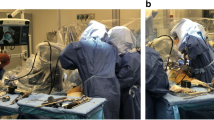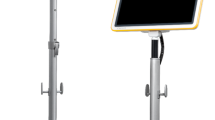Abstract
Introduction
When active robotic technologies for Total Knee Arthroplasty (TKA) were introduced over 20 years ago, broad usage of robotic technology was not felt to be needed as early data suggested no clear improvement in clinical outcomes compared to conventional techniques of implantation. Only recently has there been renewed enthusiasm for use of robotic technologies for implantation.
Materials and methods
Active robotic technology specifically refers to the use of a robot for planning and executing the surgical procedure—with surgeon guidance and control. The physical work of bone preparation is performed by a milling tool, following a cut path defined by a CT-based preoperative plan. This manuscript describes the IDE experience of the only active robotic system (ARoS) available in the US, which took place from February 2017 through December 2018.
Results
115 patients were enrolled in an IDE study to evaluate the safety and efficacy of an ARoS for TKA. No previously described safety issues for TKA occurred. Three-dimensional accuracy of component placement used the preoperative CT plan compared to the 3-months postoperative CT scan to demonstrate accuracy of all autonomous resections to within 1.5 mm and/or 1.5 degrees. Surgical planning and execution to restore alignment along kinematic principles were used in 40 procedures and to achieve mechanical alignment in 75 procedures.
Conclusions
This FDA study of an active robotic approach for TKA represented the first multicenter trial and first US experience with this technology. Results demonstrated an excellent safety profile and high degree of accuracy. Advantages of this approach relate to standardization of the technique, multiple device options in the implant library, an excellent safety and accuracy profile, and consistency of results. Active robotics for TKA represents a viable and safe technique for primary TKA.




Similar content being viewed by others
References
Borner M, Wiesel U, Ditzen W (2004) Clinical experience with ROBODOC and the Duracon Total Knee. In: Stiehl J, Konermann W, Haaker R (eds) Navigation and robotics in total joint and spine surgery. Springer-Verlag, Berlin, pp 362–366
Siebert W, Mai S, Kober R, Heeckt PF (2002) Technique and first clinical results of robot-assisted total knee replacement. Knee 9:173–180
Chan J, Auld TS, Long WJ, Kreuzer S, Campanelli V, Liebelt R et al (2020) Active robotic Total Knee Arthroplasty (TKA): initial experience with the TSolution One ® TKA system. Surg Technol Int 37:299–305
Ren Y, Cao S, Wu J, Weng X, Feng B (2019) Efficacy and reliability of active robotic-assisted Total Knee Arthroplasty compared with conventional Total Knee Arthroplasty: a systematic review and meta-analysis. Postgrad Med J 95:125–133. https://doi.org/10.1136/postgradmedj-2018-136190
Campanelli V, Lozano R, Akhlaghpour H, Brar AS, Maislin D, Nedopil AJ et al (2020) Implant placement accuracy in total knee arthroplasty: validation of a CT-based measurement technique. Quant Imaging Med Surg 10:475–484. https://doi.org/10.21037/qims.2020.01.02
Mahure SA, Teo GM, Kissin YD, Stulberg BN, Kreuzer S, Long WJ (2021) Learning curve for active robotic Total Knee Arthroplasty. Knee Surg Sports Traumatol Arthrosc. https://doi.org/10.1007/s00167-021-06452-8
Jeon S-W, Kim K-I, Song SJ (2019) Robot-assisted Total Knee Arthroplasty does not improve long-term clinical and radiologic outcomes. J Arthroplasty 34:1656–1661. https://doi.org/10.1016/j.arth.2019.04.007
Song E-K, Seon J-K, Park S-J, Jung WB, Park H-W, Lee GW (2011) Simultaneous bilateral total knee arthroplasty with robotic and conventional techniques: a prospective, randomized study. Knee Surg Sport Traumatol Arthrosc 19:1069–1076. https://doi.org/10.1007/s00167-011-1400-9
Song EK, Seon JK, Yim JH, Netravali NA, Bargar WL (2013) Robotic-assisted TKA reduces postoperative alignment outliers and improves gap balance compared to conventional TKA. Clin Orthop Relat Res 471:118–126. https://doi.org/10.1007/s11999-012-2407-3
Cho K-J, Seon J-K, Jang W-Y, Park C-G, Song E-K (2019) Robotic versus conventional primary Total Knee Arthroplasty: clinical and radiological long-term results with a minimum follow-up of ten years. Int Orthop 43:1345–1354. https://doi.org/10.1007/S00264-018-4231-1
Liow MHL, Goh GS-H, Wong MK, Chin PL, Tay DK-J, Yeo S-J (2017) Robotic-assisted Total Knee Arthroplasty may lead to improvement in quality-of-life measures: a 2-year follow-up of a prospective randomized trial. Knee Surg Sports Traumatol Arthrosc 25:2942–2951. https://doi.org/10.1007/s00167-016-4076-3
Funding
Funding was provided by THINK to conduct the IDE study to receive FDA approval of the TSolution One active robotic system.
Author information
Authors and Affiliations
Corresponding author
Ethics declarations
Conflict of interest
Dr. Stulberg received research support from THINK as a PI for the IDE study. He is also a paid consultant/speaker for THINK and has stock or stock options in THINK. Mr. Zadzilka received research support from THINK as a research coordinator.
Ethical approval
The study received ethical approval from the Western Institutional Review Board.
Informed consent
The written informed consent was obtained from all patients prior to their participation in study activities.
Additional information
Publisher's Note
Springer Nature remains neutral with regard to jurisdictional claims in published maps and institutional affiliations.
Rights and permissions
About this article
Cite this article
Stulberg, B.N., Zadzilka, J.D. Active robotic technologies for total knee arthroplasty. Arch Orthop Trauma Surg 141, 2069–2075 (2021). https://doi.org/10.1007/s00402-021-04044-2
Received:
Accepted:
Published:
Issue Date:
DOI: https://doi.org/10.1007/s00402-021-04044-2




